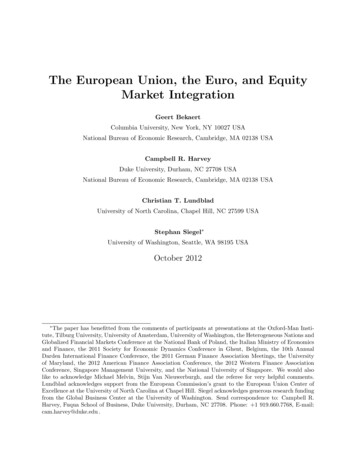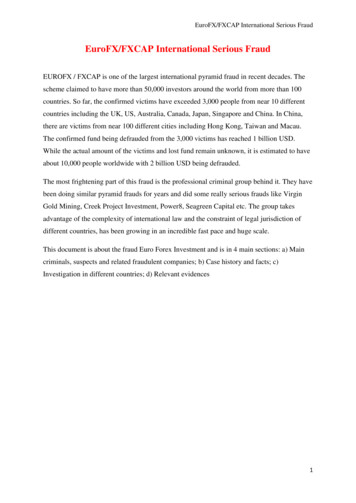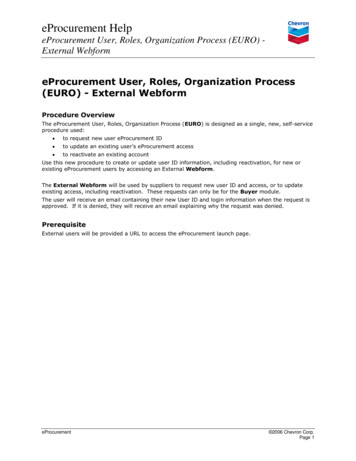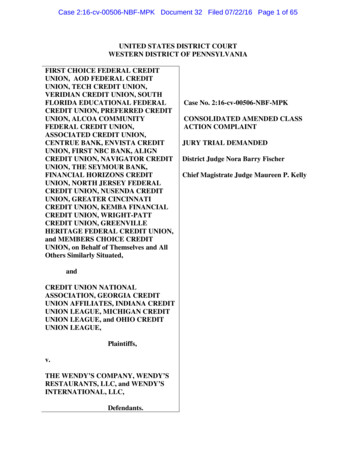
Transcription
The European Union, the Euro, and EquityMarket IntegrationGeert BekaertColumbia University, New York, NY 10027 USANational Bureau of Economic Research, Cambridge, MA 02138 USACampbell R. HarveyDuke University, Durham, NC 27708 USANational Bureau of Economic Research, Cambridge, MA 02138 USAChristian T. LundbladUniversity of North Carolina, Chapel Hill, NC 27599 USAStephan Siegel University of Washington, Seattle, WA 98195 USAOctober 2012 The paper has benefitted from the comments of participants at presentations at the Oxford-Man Institute, Tilburg University, University of Amsterdam, University of Washington, the Heterogeneous Nations andGlobalized Financial Markets Conference at the National Bank of Poland, the Italian Ministry of Economicsand Finance, the 2011 Society for Economic Dynamics Conference in Ghent, Belgium, the 10th AnnualDarden International Finance Conference, the 2011 German Finance Association Meetings, the Universityof Maryland, the 2012 American Finance Association Conference, the 2012 Western Finance AssociationConference, Singapore Management University, and the National University of Singapore. We would alsolike to acknowledge Michael Melvin, Stijn Van Nieuwerburgh, and the referee for very helpful comments.Lundblad acknowledges support from the European Commission’s grant to the European Union Center ofExcellence at the University of North Carolina at Chapel Hill. Siegel acknowledges generous research fundingfrom the Global Business Center at the University of Washington. Send correspondence to: Campbell R.Harvey, Fuqua School of Business, Duke University, Durham, NC 27708. Phone: 1 919.660.7768, E-mail:cam.harvey@duke.edu .
The European Union, the Euro, and Equity Market IntegrationAbstractWe use industry valuation differentials across European countries to study the impactof membership in the European Union as well as the Eurozone on both economic andfinancial integration. In integrated markets, discount rates and expected growth opportunities should be similar within one industry, irrespective of the country, implyingnarrowing valuation differentials as countries become more integrated. Our analysisof the 1990 to 2007 period shows that membership in the EU significantly lowereddiscount rate and expected earnings growth differentials across countries. In contrast,the adoption of the Euro was not associated with increased integration. Our resultsdo not change when the sample is extended to include the recent crisis period.
1. IntroductionNo region in the world has done more to integrate its economies than the European countries,where the European Union (EU, henceforth) set out after World War II to free the movementof goods and services, capital, and labor. As a result, financial economists have examinedthe extent of European debt and equity market integration before the onset of the recentfinancial crisis [see Baele, Ferrando, Hordahl, Krylova and Monnet (2004) for a survey ofthe literature]. Sovereign yield spreads are the dominant metric to gauge the integrationof debt markets, but measuring equity market integration is more challenging. Most of theexisting research has used equity returns to measure the relative importance of an EU returnfactor (e.g. Hardouvelis, Malliaropulos and Priestley, 2006), dispersion or correlations trends(e.g. Adjaouté and Danthine, 2004), or the degree of news and volatility spill-overs amongEU countries (see, for example, Baele, 2005; Fratzscher, 2002). A few studies have alsoinvestigated quantity-based measures; for example, Jappelli and Pagano (2008) documentthe degree of home bias over time.We offer a different approach. We use stock market valuations of industry portfolios indifferent countries to assess the degree of bilateral integration in Europe and the impact of theEU between 1990 and 2007. Stock market valuations reflect financial integration throughtheir impact on discount rates as well as economic integration through their impact oncapitalized growth opportunities. As we argue below, integration should lead to “valuationconvergence” of similar firms across different countries.In contrast to existing studies on equity market integration, our method is essentiallymodel-free, only requiring valuation ratios and therefore avoiding the joint hypothesis problem plaguing extant studies using equity return data. Valuation ratios also are much lessvolatile than equity returns allowing more powerful statistical tests. Concretely, we proposeabsolute differences of earnings yields, the inverse of price-earnings ratios, across industriesin different countries, as an easily interpretable segmentation measure.Our focus on valuation has the advantage that it captures the wider impact the EUmay have had on integration before the recent financial crisis. For example, increased price1
competition may have also led to valuation convergence and be driven by EU membership.1It is, of course, of interest to disentangle discount rate (financial market integration) fromcash flow (economic integration) effects.We establish that between 1990 and 2007 EU membership reduced average bilateralearnings yield differentials by about 150 basis points in our most general specification. Thisis a large change in valuation differences. Using an empirical approach to separately measureexpected returns and expected earnings growth rates, we find EU membership led to strongconvergence of both, but the effect on discount rates was the largest. We also comparevaluation differences in Europe with valuation differences computed from randomized U.S.portfolios, matched by industry composition and the number of firms per industry-countrypair to our European data. At the end of 2007, bilateral valuation differentials withinEurope were still significantly above the levels observed in U.S. data, but conditioning onEU membership, they had become indistinguishable from those observed in U.S. data in2000.Of course, EU membership is not exogenous; country characteristics that increase thelikelihood of early EU membership, such as economic and institutional development, may wellbe correlated with a higher propensity to integrate with other member countries. Moreover,this convergence happened against the backdrop of a global integration process that led tovaluation convergence across the world (see Bekaert, Harvey, Lundblad and Siegel, 2011).However, the strong EU effect we mentioned is conditional on a variety of cross-sectionaland temporal controls, including a control for global integration. While it is very difficultto establish causality, the EU effect holds in a difference-in-differences specification thatcontrols for country-pair and year fixed effects. It also survives and becomes even stronger inan instrumental variables regression, where we use the distance to Brussels as an instrumentfor EU membership. Many of the institutions of the EU are established in Brussels and a1There is a large economics literature attempting to assess the degree to which the European Union didor did not succeed in integrating markets across member countries in a wide sense. While Krueger (2000)finds that labor mobility among member countries did not significantly increase after the elimination ofthe remaining restrictions in 1993, Nicoletti, Haffner, Nickell, Scarpetta and Zoega (2001) document thatgoods prices, especially for tradables, are more similar within the EU than among other OECD countries.Blanchard and Giavazzi (2002) argue that increased trade and cross-border investment among EU membercountries have weakened the association between national savings and investments more among EU and inparticular Euro member countries than among other OECD countries.2
larger distance from Brussels slows down EU ascension.While much of the pre-crisis literature has stressed the effects of the introduction of theEuro on integration in Europe, by the end of 2007 we find the Euro did not significantlycontribute to integration. Moreover, the EU effect is unchanged when the Euro introductionis added as an extra control.Most of our paper focuses on the 1990-2007 sample period which covers the expansion ofthe EU across many countries as well as the completion of the “single market” that allowsfor the free movement of goods, capital, people, and services between EU members andthe implementation of a large number of EU directives to harmonize regulation of capitalmarkets and financial services.We also confront the recent Eurozone crisis. We consider a monthly sample that extendsthe data through July 2012. Given that the crisis is such a massive event, it is reasonableto divide the empirical work into pre-crisis and full sample. Our main finding that EUmembership increases integration, while Euro adoption does not, is robust using a full samplethat includes the crisis.The remainder of the paper is organized as follows. In Section 2, we present our segmentation measure and characterize its evolution over time. Because the segmentation measuremay be affected by temporary fluctuations in valuations and is bounded from below by zero,we establish a benchmark using randomized U.S. portfolios. Section 3 sets out our mainregression framework and establishes the main results. In Section 4, we consider potentialchannels through which EU membership may have affected valuation differentials, examiningamong others, trade, FDI, regulation, financial development and differences in real interestrates. In Section 5, we provide results based on data that include the recent Eurozone crisis.The final section offers some concluding remarks.3
2. Integration through a valuation lens2.1. A market segmentation measureAs a starting point, consider the Gordon growth model, which assumes that the discountrate, r, is constant and expected earnings grow at a constant rate, g. If a firm pays out allearnings every year, its earnings yield simply is r g. Hence, in this simple model, discountrates and growth opportunities are linearly related to the earnings yields. Assume that theworld real interest rate is constant and systematic risk is industry rather than firm specific,as is typically assumed in capital budgeting.2 These assumptions are more plausible whenthe industry structure is quite granular so that industries are comparable across countries.Financial market integration then equalizes industry betas as well as industry risk premiaacross countries. Furthermore, assume that in economically integrated countries persistentgrowth opportunities are mostly industry rather than country specific or at least rapidlytransmitted across countries.3 It then follows that the process of market integration shouldcause valuation differentials between industries in different countries to converge. We buildon this intuition to create bilateral valuation differentials that serve as our segmentationmeasure.Specifically, let EYi,k,t denote industry k’s earnings yield in country i at time t and EYj,k,tthe corresponding value for the same industry k in country j. Our main variable of analysisis the absolute value of the difference between the two industry valuations, EYi,k,t EYj,k,t .The weighted sum of these bilateral industry valuation differentials is our measure of thedegree of effective or de facto equity market segmentation between these two countries:Ni,j,tSEGi,j,t XIWi,j,k,t EYi,k,t EYj,k,t ,(1)k 1where IWi,j,k,t is the relative market capitalization of industry k and Ni,j,t is the numberof industries for country-pair i, j at time t. The relative market capitalization of a given2It is well known that that real interest rate variation does not account for much variation in valuationratios.3This is plausible as firms in the same industries face similar production processes and market conditions(again under the null of free competition and lack of trade barriers).4
industry is calculated as the combined market capitalization of the industry in both countriesdivided by the combined market capitalization of all industries in both countries. With thisweighting scheme the industry structure of the country with the larger equity market hasmore influence on the segmentation measure.Bekaert et al. (2011), contrasting local and global valuation ratios, point out a numberof biases in this type of segmentation measure. Country-specific differences in financialleverage may cause different valuation ratios even when asset market betas are equalized. Ina dynamic setting, financial and economic integration does not restrict the volatility of theshocks to earnings growth rates and discount rates, but they will nonetheless be reflected invaluation ratios. In addition, the number of firms in a particular industry should affect theaccuracy of the measure. Given that we use absolute values of yield differentials, noise willbias the measure upward, so it should be decreasing in the number of firms present in theindustry. However, it is straightforward to control for these biases in a regression analysis,which is what we do in this article.Note that our measure requires nothing more than industry-level valuation ratios whichare observed at every point in time. This contrasts with the standard approach in the international finance literature that employs estimated measures of segmentation based on, forexample, the evolution of equity return correlations or systematic risk exposures (e.g., worldmarket portfolio betas); see Bekaert, Hodrick and Zhang (2009) and the references therein.However, the construction of such measures requires both historical data and a particular estimation method. Furthermore, the interpretation of these measures often requires a formalinternational asset pricing model, about which there is little consensus.2.2. An initial assessment of integration in EuropeWe construct our measure of bilateral valuation differentials, SEG, for a sample of 33 European countries listed in Table 1, using monthly firm-level data from Datastream from 1990to 2007. While we construct monthly SEG measures, our subsequent analysis is at theannual frequency given the availability of other variables. We identify all local equity securities in these countries covered by Datastream and traded on a public exchange. Depository5
receipts as well as preferred stocks are excluded, as are securities whose International Securities Identification Number (ISIN) is not local. We then obtain monthly earnings yield,market capitalization (in USD) as well as USD return data. Datastream generally reportstrailing 12-month earnings yields, where negative yields are set to zero. In addition, we deleteearnings yields that are larger than one. Using Datastream’s industry classification system,4we form 38 value-weighted industry portfolios for all countries. For each country-pair, wecompute SEGi,j,t as described in (1). The number of country-pairs with non-missing datais growing over time, from 120 country-pairs in 1990 to a maximum of 528 country-pairs.To avoid the possibility of mis-measured outliers influencing the full sample, we delete, forevery year separately, observations with a segmentation measure equal to or larger than the99th percentile of the segmentation measure for that year. The complete data set contains5,665 observations.Appendix Table 1 (Panel A) reports summary statistics, suggesting that on averagesegmentation between EU member countries was about two percentage points lower than forthe rest of the sample. This could reflect the EU’s efforts with respect to general economicintegration (e.g. trade), which have been ongoing for decades, or, efforts with respect tocapital account liberalization (completed in 1992) and the harmonization of capital marketregulation (still ongoing). Because the financial market integration process was jump-startedby the Single European Act of 1986 with countries such as France, Italy and Belgium, relaxingcapital controls a few years later, we start the sample only in 1990. However, our subsequentresults are robust to starting the sample in 1980.During our sample period, the segmentation level among EU countries was 3.8%. Giventhe segmentation measure uses absolute differences in earnings yields and need not be zerounder the full null of financial and economic integration, it is not clear whether this levelis “close” to integration or not. Therefore, we use U.S. equity market data to measure theaverage level of segmentation for fictitious country-pairs that mimic our European pairs, butexclusively reflect U.S. valuations. To the extent that the U.S. is financially and economically4Datastream employs the Industry Classification Benchmark (ICB) framework. For a list of the 38industries used in our study, see the Online Appendix. The industry is determined by the source of a firm’srevenue or the source of the majority of its revenue. Firms that are not classified as one of these 38 industriesare excluded from our study.6
integrated, this exercise provides us with a meaningful benchmark to judge whether Europeancountry-pairs are segmented or not. In particular, we identify all U.S. stocks that are coveredby CRSP and Compustat. We obtain four quarter trailing earnings from Compustat andcombine these with firm-level equity market capitalization from CRSP to calculate firm-levelearnings yields.5 As in our European data set, we set negative earning yields to zero andearnings yields larger than unity to missing. Next, we use these U.S. data to form countryindustry portfolios by randomly drawing firms from the U.S. data set, mimicking the numberof firms found in a given country-industry portfolio in a given year in our European data.We draw from the U.S. sample with replacement, as the total number of European firms perindustry can be larger than the total number of available U.S. firms in that industry.6 Wethen use these U.S. data based country-industry portfolios to calculate bilateral segmentationmeasures as described above. We repeat this process 500 times and thus obtain a distributionof the average level of bilateral segmentation to which we can compare the actual level ofsegmentation observed in Europe as well as in the European Union.Figure 1 shows the average random U.S. benchmark segmentation level corresponding tothe set of all European country-pairs from 1990 until 2007, together with a 90% confidenceinterval. Note that, even though the U.S. is an integrated market, the level of measuredsegmentation was mostly in the 2 to 4% range. Also shown is the average segmentationlevel for all EU and for all non-EU European country-pairs.7 With the exception of 2005,the valuation differentials of non-EU country-pairs were above the 90% confidence intervalof valuation differences in the U.S. In contrast, the measured segmentation levels across EUcountries were similar to those in the U.S. by 2000. After 2000, segmentation was again largeracross EU members than in the U.S. but still lower than for non-EU pairs. Importantly,this does not necessarily mean that EU membership was the cause of integration. For5In particular, we obtain “Income Before Extraordinary Items” (IBADJQ) for the previous four quarters.We pair these earnings with the market value of all outstanding equity securities at the end of December.We only use earnings data up to the end of September. Using industry information provided by Compustat(GICS and SIC codes), we assign an ICB code to each firm. For about 3% of all observations, we are unableto identify the appropriate ICB code.6In a robustness exercise, we repeat the experiment, but ensure that each country-industry portfoliocontains at least one unique firm. In very few cases, this is impossible as the total number of U.S. firms in agiven industry is smaller than the number of countries. We find that our results are essentially unchanged.7EU country-pairs are pairs where both countries are EU members, all other country-pairs are non-EUcountry-pairs.7
example, a plausible alternative hypothesis is that the general movement towards globalmarket integration led to narrower valuation differentials across equity markets in the EU.Nevertheless, this still begs the question of why this convergence was more pronounced forEU country-pairs than for Europe as a whole. In the next section, we use a regressionframework to address this question.One potential problem with a focus on our full sample is that the sample is unbalanced.Moreover, with the emergence of Eastern European countries in the 1990s, the sample composition changes substantially over time. We therefore focus our initial analysis on a balancedsample of 120 country-pairs for which we have data since 1990.8 This sample excludes allEastern-European countries; see Table 1 for a list of all countries included. For this balanced sample of 2,160 observations, Panel B of Appendix Table 1 shows EU membershipwas associated with lower segmentation (about 1.25%).3. The EU and integration3.1. Benchmark empirical modelIn this section, we investigate the effect of EU membership on bilateral equity valuationdifferentials, controlling for several potentially confounding factors. The linear regressionmodel is:SEGi,j,t a bEU EUi,j,t bX Xi,j,t ci,j dt i,j,t ,(2)where EUi,j,t is an indicator that is one in year t if both countries are EU members andzero otherwise, Xi,j,t represents a set of controls, and ci,j and dt represent country-pair andyear fixed effects. All standard errors are robust to arbitrary correlation over time withincountry-pairs and across country-pairs within years (see Thompson, 2009; Cameron, Gelbachand Miller, 2006; Bertrand, Duflo and Mullainathan, 2004).9 Appendix Table 2 discusses8Differently from the full sample, we do not drop observations in the top one percent of the segmentationdistribution.9Adjusting standard errors for contemporaneous correlation across country-pairs is particularly important given that we use a measure of bilateral segmentation. Country-pairs that share one country are notindependent of one another. We Paccount for cross-sectional correlation by calculating the variance of the 1 1coefficient estimates as (W 0 W ) ( t Wt0 t 0t Wt )(W 0 W ) where Wt is the Nt k matrix of all k right hand8
the data sources and construction of all variables used in our analysis.Table 2 reports the result for the balanced sample of a regression of country-pair valuationdifferentials on the EU indicator and different sets of controls. The first specification includesthe EU indicator and the sum of the number of firms from both countries (in natural logs)used to calculate the segmentation measure,10 as well as the average absolute difference inindustry leverage, in industry earnings growth volatility, and in industry return volatilityfor a given country-pair in a given year. These variables may cause variation in the SEGmeasure unrelated to the degree of integration. The first specification suggests that absolutevaluation differentials were about one percentage point lower between EU member countries.As expected, segmentation was negatively and significantly associated with the number offirms, and positively associated with leverage and volatility differences.The second specification in Table 2 also includes three country-pair characteristics. Givenit is natural to expect that countries with similar economic development have similar growthopportunities and narrower valuation differentials, we include the average difference in percapita GDP in 1990. Since EU membership is likely correlated with economic development,this is a potentially important control variable. One of the main findings in the homebias literature is that investors tend to invest relatively more in countries that are closeby and “familiar” (see Chan, Covrig and Ng, 2005; Portes and Rey, 2005). To control forsuch familiarity effects, we include the distance between the two countries in a countrypair (measured in 1,000 kilometers between the most important cities) as well as a commonlanguage indicator as additional controls. Note that the inclusion of these time-invariantcontrols actually increases the absolute EU effect to 160 basis points. Economic developmentdifferences surprisingly decrease segmentation. The distance between two countries had aside variables for all Nt country-pairs in year t. Consider a regression of the segmentation measure on the EUindicator alone (point estimate -0.0169), but including country-pair and year fixed effects. The heteroskedasticity robust standard error for the EU effect is 0.0023, while accounting for contemporaneous cross-sectionalcorrelation yields a standard error of 0.0041. Finally, accounting for contemporaneous cross-sectional correlation as well as time-series correlation within country-pairs (as we do in all specifications) yields a standarderror of 0.0049.10In unreported results, we consider additional controls related to the number of firms used to calculatethe average bilateral industry valuation differential. In particular, we include the minimum as well as theabsolute difference of the number of firms averaged across the relevant industries. The latter may alsocapture competitive differences across countries. We find that the estimated effect of joint EU membershipis unchanged.9
positive and statistically significant effect, suggesting that an additional 1,000 kilometers indistance was associated with an additional 0.65 percentage point valuation differential. Acommon language appears to have had little effect on valuation differentials.The third specification in Table 2 adds two time series variables. Most importantly,we distinguish regional from global integration by including the earnings yield differentialbetween the “Core European” countries11 and the U.S. This differential should capture integration between the U.S. and Europe (‘global integration’) and could therefore indirectlyaffect valuation differentials across European countries. We also include the market earningsyield for Core Europe because the variability of earnings yields may be higher at higher yieldlevels. Both variables are statistically significant and have the expected sign. The effect ofsegmentation between Europe and the U.S., reflecting the underlying trend of global marketintegration, was economically important, as for every 1% decrease in global segmentation,intra-European differentials decreased by 1.5%. The time controls reduce the EU effect backto 1%, but it remains highly significant. Note that the addition of controls has also increasedthe R2 from 12% in specification 1 to 33% in specification 3.While we have attempted to control for factors that might affect bilateral valuationdifferentials as well as EU membership, it remains possible that additional unobservablecharacteristics led to a bias in our coefficient estimates for the EU indicator. To the extentthat these unobservable characteristics are time-invariant, we can address the endogeneityconcern by including country-pair fixed effects (see Glick and Rose (2002) for a similar application), essentially identifying the change in segmentation due to a change in membershipstatus. In specification 4, we reestimate specification 1 augmented by country-pair and yearfixed effects, which yields a difference-in-differences (DID) estimation. In this specification,we, of course, cannot include time-invariant or country-invariant controls. Not surprisingly,the R2 increases dramatically (to 47%), but at -143 basis points (bp) the EU effect becomesmore, not less important. Examining the four different specifications, controlling for crosssectional characteristics seems to increase the magnitude of the effect whereas adding timecontrols reduces it. The DID specification yields a stronger EU effect on segmentation than a11Namely Belgium, Denmark, France, Germany, Ireland, Italy, Luxembourg, the Netherlands, and theUnited Kingdom.10
simpler specification, such as specification 1, which fails to properly control for time-invariantcountry-pair effects and global integration.Finally, note that the EU effect extends over the two decades of our 1990 to 2007 sampleperiod. Using the DID specification, we find, in untabulated results, significantly negativepoint estimates of -1.52% for the 1990s and of -1.11% for the 2000 to 2007 period.3.2. Discount rates or growth opportunities?From the Gordon growth model, we know that the earnings yield reflects the cost of equity capital and/or expected earnings growth. While we measure absolute differences, EUmembership typically reduced earnings yields towards the levels observed for existing EUmembers. Hence, our results indicate that EU membership was accompanied by a reductionin the cost of capital and/or an improvement in growth opportunities. Measuring theseeffects separately is of considerable interest, because the EU’s impact on financial market integration likely operated through changes in the cost of capital, whereas changes in expectedearnings may have been associated with a variety of EU-induced measures to promote trade,labor mobility, and competition.Measuring expected returns and expected earnings growth rates is challenging. To do so,we specify an empirical model of annual returns and earnings growth rates as well as earningsyields at the country-industry portfolio level, specified at a monthly frequency. Specifically,we estimate a system of three equations:DRri,k,t 12 α0,t α1,t Zi,t α2,t ZtDR ri,k,t 12(3)GOgi,k,t 12 δ0,t δ1,t Zi,t δ2,t ZtGO gi,k,t 12 DRDR EYi,k,t 12 γ0 γDR α0,t 12 α1,t 12 Zi,t 1 α2,t 12 Zt 1 GOGOγGO δ0,t 12 δ1,t 12 Zi,t 12 δ2,t 12 Zt 12 EYi,k,t 12 ,where ri,k,t 12 and gi,k,t 12 are the realized annual equity returns and earnings growth rates(in USD), respectively, for the country (i) - industry (k) portfolio between time t and t 12;Zi,t and Zt are vectors of local and international predictors of returns and earnings growth11
rates. The parameters αm,t and δm,t , for m 0, 1, and 2, r
Christian T. Lundblad University of North Carolina, Chapel Hill, NC 27599 USA . the 2011 German Finance Association Meetings, the University of Maryland, the 2012 American Finance Association Conference, the 2012 Western Finance Association . Harvey, Fuqua School of Business, Duke University, Durham, NC 27708. Phone: 1 919.660.7768, E-mail:











